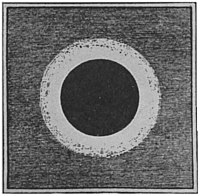The pear-shape is, however, not caused by this atmosphere being illuminated (though this illumination causes trouble of another kind), but by the peculiar behaviour of light when a bright light is screened off. Near the edge of the screen we get peculiar appearances which go by the name of diffraction. You can see them if you look (with one eye only) at the sky through two finger-tips nearly closed together: when
they are very close, one seems to go out to meet the other, though you can feel that they are not yet touching. Astronomers knew that there would be these "diffraction" appearances, but they hoped to make good allowance for them by practising beforehand with models of the expected Transit which were ingeniously constructed. But they were disappointed. They knew they had been disappointed long before they collected and compared the observations made at different stations; because two people side by side using similar telescopes gave quite different times instead of the same time. Hence they knew that one of them, and perhaps both, must be wrong: and you cannot get a right result from wrong observations.
Transits of Venus only rarely occur. We have

